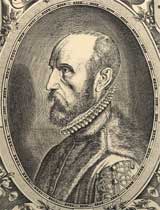Blaeu Atlas of Scotland, 1654
Abraham Ortelius (1527-1598)
 Born into an old Antwerp family, sympathetic to the Reformation, Abraham Ortels adopted the Latinised form of his name in the 1540s when he began work as a seller of books, coins, antiques and maps. His scientific, historical and collecting interests developed as his business prospered, and he was able to travel extensively around Europe, building up a wide circle of friends. Amongst these was Gerard Mercator, 15 years his senior, whom he first met at the Frankfurt Book Fair in 1554, and with whom he was to correspond throughout his life. By the 1560s the Hungarian scholar Johann Sambucus was to address Ortelius as 'cosmographer', and in 1564 Ortelius published his first map, a large wall map of the world.
Born into an old Antwerp family, sympathetic to the Reformation, Abraham Ortels adopted the Latinised form of his name in the 1540s when he began work as a seller of books, coins, antiques and maps. His scientific, historical and collecting interests developed as his business prospered, and he was able to travel extensively around Europe, building up a wide circle of friends. Amongst these was Gerard Mercator, 15 years his senior, whom he first met at the Frankfurt Book Fair in 1554, and with whom he was to correspond throughout his life. By the 1560s the Hungarian scholar Johann Sambucus was to address Ortelius as 'cosmographer', and in 1564 Ortelius published his first map, a large wall map of the world.
Ortelius' main fame rests upon his role as the maker of the world's first conventional atlas, his Theatrum Orbis Terrarum (1570). For this he synthesized the best available geographic information of the day into his own maps of a regular size and style, engraved mainly by Franz Hogenberg. Compiled largely during the 1560s, and first published with 70 maps based on the work of 87 cartographers listed in the preface, 'the importance of the Theatrum ... for geographical knowledge in the last quarter of the sixteenth century is difficult to overemphasize' (Karrow, 1993, p.9). It went through 24 editions in Ortelius' lifetime, and another 10 after his death in 1598, continually expanding in content to include 167 maps by 1612. Its texts were translated into Dutch, German, French, Spanish, English and Italian, and it was owned all over Europe. His map of Scotland first appeared in the 1573 Additamentum to the Theatrum, copied primarily from Mercator's 1564 map of the British Isles.
Ortelius continued to travel, and in 1573 he toured the South Netherlands with various humanist friends, partly as a homage to Gerard Mercator. The account of his trip was published as the Itinerarium in 1584. In 1575 he visited Italy to study coins and other antiquities. In 1577 he escaped from religious strife in the Netherlands by visiting London, where, amongst others, he met William Camden, John Dee and Richard Hakluyt.
As well as pocket-sized editions of the Theatrum, often termed Epitomes, Ortelius published a dictionary of place names, standardising ancient, modern and vernacular forms (1578), as well as an alphabet of Ptolemy's names (1579). In later life he turned his attention increasingly to historical maps, published as the Parergon. He died in 1598 and was buried in his home town of Antwerp.
Karrow, R.W., Mapmakers of the sixteenth century and their maps (Chicago, 1993)
